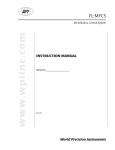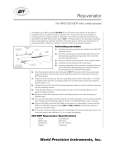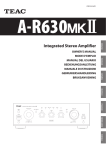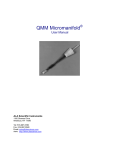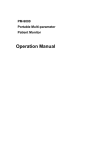Download World Precision Instruments
Transcript
MPS-2 www.wpiinc.com Multichannel Perfusion System INSTRUCTION MANUAL Serial No._____________________ 100405 World Precision Instruments MPS-2 Contents Introduction........................................................................................ 1 Packing List........................................................................................ 2 General Warnings and Cautions......................................................... 4 Hardware Installation......................................................................... 4 MPS-2 Controller Operation................................................................ 6 START button.................................................................................................... 6 RESET button.................................................................................................... 6 MODE button.................................................................................................... 6 Manual Perfusion Mode.................................................................................... 6 Master Manual Perfusion Mode........................................................................ 7 On-line Perfusion Mode.................................................................................... 7 Off-line Perfusion Mode .................................................................................. 7 TTL Control Mode .......................................................................................... 7 Hardware Testing Procedure............................................................. 8 Software Installation and Operation.................................................. 9 Creating a New Perfusion Experiment.............................................................. 9 Saving Your Experimental Parameters........................................................... 12 Mode Selection............................................................................................... 12 Computer Perfusion Control Modes............................................................... 13 Cleaning............................................................................................ 14 Perfusion Trouble-shooting.............................................................. 15 Appendix........................................................................................... 16 Specifications................................................................................................. 16 Testing Drug Delivery..................................................................................... 16 Determining Flow Rate................................................................................... 17 Calculating Junction Volume.......................................................................... 18 Warranty............................................................................................ 19 Copyright © 2005 by World Precision Instruments, Inc. All rights reserved. No part of this publication may be reproduced or translated into any language, in any form, without prior written permission of World Precision Instruments, Inc. World Precision Instruments MPS-2 Introduction The MPS-2 is a programmable 8-channel perfusion system designed for single channel and whole-cell patch preparations. It offers the best combination of performance and value. The MPS-2 incorporates the same high quality solenoid valves found on similar but much more expensive systems. Unlike other perfusion systems on the market, which often compromise performance to fit every possible application, the MPS-2 is the only perfusion system designed and optimized specifically for single-channel and whole-cell patch perfusion applications. The MPS-2 is therefore the best perfusion system on the market for these specific applications and is offered at a very attractive price. The system can be controlled manually (i.e., via membrane switches on the front panel) or through a PC. Two different manual control modes are offered. One controls each channel independently and the other mode allows the user to assign a master channel that will keep the system flowing when all other channels are switched off. User-friendly timing software is included, and the programmed perfusion sequence can be started by computer, a TTL trigger from an external source such as a patch clamp amplifier, or manually by the user. The TTL control mode that permits independent control of each valve by an external instrument or data acquisition system. The perfusion fluid flows through specially designed color-coded polyurethane ribbon style tubing. The color-coding allows the user to easily trace each channel for diagnostic or set up. The ribbon style of the tubing keeps the system very neat and clean. Unlike PVC based tubing, polyurethane tubing contains no plasticizer, which can cause contamination. The most unique feature of the MPS-2 is its perfusion micro-manifold. Using the latest microfluidic techniques, the injection molded micro-manifold provides the least flow resistance and dead volume of any product on the market. The flow channel inner diameter is approximately 1 mm, except for the last 5 mm before the junction point. This design allows a fast flow rate without using a pressured system. The maximum flow rates are 1 and 16 microliter per second for the 15 mm long 100 µm and 250 µm ID tips, respectively. Small channels and a unique design at the merging point further reduce the chance of cross contamination. Dead volume is less than 100 nL. The injection-molded micro-manifold is also designed as an economical disposable item, eliminating problems of cross-contamination from other experiments. World Precision Instruments MPS-2 Packing List After unpacking, check the following items to make sure that all the perfusion system parts have been received in a perfect condition. Item Quantities MPS-2 Controller................................................................................. 1 Valve Console..................................................................................... 1 Syringe Holder.................................................................................... 1 Stand base and Stainless Steel Post.................................................. 1 Power Cord......................................................................................... 1 USB Cable.......................................................................................... 1 DB9-to-BNC 8-cable assembly.......................................................... 1 1 Amp Fuse......................................................................................... 2 10 mL Syringes................................................................................. 10 3-way Stopcock................................................................................ 10 Luer fitting with barb for 1/16” ID tubing........................................... 10 Color Coded Polyurethane Tubing Ribbon..................................... 5 ft. Tubing for making micro-manifold cleaning adaptor.................... 3 in. Micro-manifold Holding Rod............................................................... 1 Micro-manifold With 100 µm ID tip..................................................... 2 Micro-manifold With 250 µm ID tip..................................................... 2 User’s Manual..................................................................................... 1 Installation Software . ......................................................................... 1 MPS-2 controller World Precision Instruments MPS-2 Valve console Syringe holders Luer fitting for 1/16” ID tubing (WPI #13156-100) Micro-manifold 100 µm: (WPI #502110) 250 µm: (WPI #502125) Manifold Holder 10 mL syringes (WPI #3744-100) Stand, post 3-way stopcock (WPI #14057-10) World Precision Instruments MPS-2 General Warnings and Cautions 1.Read the user manual thoroughly before operating the MPS-2 multichannel perfusion system. 2. Before starting a formal experiment, perform several preliminary tests, such as the drug interaction range test, to get familiar with this perfusion system. 3.The 100 and 250 micron perfusion manifold tips are made of fine glass capillary, which is subject to breakage and clogging. Handle the tip carefully during the experiment. 4.Tubing must be removed gently so that the manifold is not damaged. 5. Any organic solvent, including alcohol, may damage the perfusion manifold. If it is absolutely necessary to rinse the perfusion head with alcohol, use ethyl alcohol only. 6. All the drug solutions should be filtered before use to prevent clogging of the perfusion head. 7. After the experiment, the tubing system (especially the electromagnetic valve, manifold and perfusion head) should be thoroughly washed with fresh distilled water as soon as possible. Failure to do so may cause damage to the system. 8.In case MPS-2 system does not work properly, stop the experiment immediately. Switch off the power and go to the Troubleshooting section of this manual. Hardware Installation 1. Set the MPS-2 perfusion stand on a stable platform. 2.Insert the stainless steel post into the base and tighten the screw. 3.Loosen the screw on the back of the valve console and fix it onto the post. Set the distance between the valve console center point and top of the post to the desired height. 4. Fasten the syringe holder onto the post. World Precision Instruments MPS-2 5.Connect the valve console to the MPS-2 instrument with the cable supplied. 6. Pull out of the plungers of the syringes and put the syringes into the syringe holder. 7.Connect the 3-way stopcocks to the syringes. 8.Cut a 20 cm long section of the color-coded polyurethane tubing. Split it to 8 individual tubes and put the luer fitting to one end. Connect the luer fitting to the 3-way stopcock. 9.Connect the other ends of the eight tubes to the inputs of the valve console. 10. Split one end of the long color-coded polyurethane tubing for about 15 cm. Connect the splited end to the valve output port on the valve console. 11.Carefully connect the other ends of the polyurethane tubing to the micromanifold. In this step, the manifold should not be connected to the holding rod. The female luer port may be damaged by the force applied to the manifold when attaching the 8 ends of the tubing. 12.Connect the stainless holder rod to the micro-manifold. The end of the holder rod is a male luer fitting. It can be pressed into the center hole of the micro-manifold for a secure holding. Fix the holder to a micromanipulator. We recommend WPI’s KITE-L for this purpose. It has sufficient precision for the perfusion tip and an economical price. It has a left hand scale for placing on the left side of the microscope, leaving the right side free for the patch pipette. 13.Connect the MPS-2 to the computer’s USB port. 14.The DB9-to-BNC cable assembly connects to the control input port on the back of the MPS-2. World Precision Instruments MPS-2 MPS-2 Controller Operation The left section of the MPS-2 front panel contains the “START”, “RESET” and “MODE” buttons, and three functional indicator LEDs: START button The button runs the perfusion process. In the “On-line” mode, it acts as the button and runs the experiment controlled by the perfusion software. In “Off-line” mode, the “START” button will run the preset perfusion parameters saved to the RAM of the control box from the computer. RESET button is the zero button for the micro-controller. It will stop any currently running experiment, turn all channels off, and reset the mode to “Manual”. . MODE button rotates the perfusion mode between “Manual”, “On-line”, “Off-line”, and “Master Manual”. Once a mode is selected, the corresponding LED will light up. In “Master Manual” mode, the “MANUAL” LED blinks continuously. The operation of each mode is described in the following sections. World Precision Instruments MPS-2 Manual Perfusion Normal Mode In this mode, the 8 channels are independently controlled by pressing the channel buttons. When a channel is on, its LED lights up. Master Channel Mode This is just like the normal “Manual” mode except that only one channel can be on at a time. If all other channels are turned off, channel 8 (the master channel) automatically turns on. When this mode is first selected, it is in the inactive state in which all channels are turned off. Press the channel 8 button to toggle between the active and inactive state. On-line Perfusion Mode This is the computer software controlled mode. There are three ways to run the perfusion experiment: by clicking the (Run) button in the software, by pressing the “START” button on the front panel, or by using the external triggered TTL input. While an experiment is running from the computer, channels can also be turned on and off by pressing the channel buttons. Off-line Perfusion Mode In this mode, the user can use “START” button or externally triggered TTL input signal to start the perfusion program and perform the perfusion according to the preset parameters saved in the control unit’s RAM from the computer. Note that there is a delay of about 25 ms while the stored sequence is initialized. Perfusion cannot be independently controlled with the channel buttons in this mode. TTL Control Mode Each channel is independently controlled by its own TTL input. The MPS-2 goes into this mode when any one of the control inputs goes high (>2.0 V). While this mode remains active, the “OFF-LINE” LED will blink continuously. The MODE button is disabled, but RESET can still be used to close all open valves and return to Manual mode. Press any of the Channel keys if the experiment has to be manually halted. This will exit out of TTL Control mode and prevent it from going back into that mode until RESET is pressed, or the instrument is turned off and on. World Precision Instruments MPS-2 Hardware Testing Procedure In order to make sure the perfusion system works perfectly, the connection of the tubing to all of the valves and connectors should be sealed tightly without any leakage of the air pressure. In addition, there should not be any air bubbles present inside the output of the tubes. Since the inner diameter of the tubing is so small, if an air bubble is present inside the tubing the flow of solution will stop due to blockage by air. Therefore, before the experiment, use the following procedure (commonly referred to as priming) to check for air leakage and remove the bubbles in the tubing: 1. Fill all the syringes with the distilled water and open the 3-way stopcock. Check if there is any water leakage. If any, find out the proper reasons and fix the leakage. 2.Turn on the power. 3.Turn on the first channel switch, until water droplets come out from the micro-manifold tip. 4.During step 3, air bubbles might prevent the water droplets from coming out of the tubing. To clear all air from the system, attach a syringe filled with distilled water to the side port of the stopcock. Turn the stopcock knob so that the syringe on the upper port is disconnected and push the air out with the side port syringe. Repeat steps 3 and 4 for channels 2 to 8. 5.Carefully put on the micro-manifold. Turn on and off the channel switches for channel 1 to 8, until the water droplets come out of the micro perfusion head continuously 6.Determine the flow velocity at the micro perfusion head from each channel by a stopwatch. Flow velocity for different channels should be about the same. Otherwise, check the air leakage or residual bubbles in the corresponding channel. World Precision Instruments MPS-2 Software Installation and Operation System Requirements: Pentium II, Celeron or higher, or 100% supported CPU, 10Mb free hard drive space; CD-ROM or DVD-ROM driver. Installation: Insert the CD into the CD-ROM. Run “Setup.exe” and the system will automatically guide you through the installation procedure for the MPS-2 software. The first time the MPS-2 is connected to the USB port of the computer, Windows will automatically search for the driver for the new device. After the installation is complete, you will see the MPS-2 listed in the Device Manager under “Universal Serial Bus Controllers”. Startup: The perfusion software can be found in the Start menu of Windows under Programs\MPS-2. The software automatically connects to the MPS-2 on startup. If the MPS-2 is plugged into the computer after the program has been loaded, press the button to establish a connection. Creating a New Perfusion Experiment The Experiment menu allows you to open a new or existing perfusion experiment. After clicking on “New Experiment”, two new windows will pop up to allow the user to set the experimental parameters. World Precision Instruments MPS-2 Set the Experiment Time The first step in creating a new experiment is to set the (Total) Experiment Time. The format is Hours:Minutes:Seconds:Milliseconds. If left mouse key is held down over one of these fields, a double arrow ( ) will appear and the value can be adjusted by moving the mouse up or down. If you double click on a field, the value can be entered directly with the keyboard. Move to the next field by filling in both digits of the field or by pressing the spacebar. Click Apply when all fields are set to the desired values. The perfusion time below is set for 2 minutes. Preset each channel’s perfusion time Choose the desired channel by clicking on the box in front of the channel name in the experiment window, or by clicking on the channel number in the setup window. In this example, we will be working with the 5th channel. Press the Insert button on the bottom of the setup window to add a Start Time and Stop Time. Click once on a start time or a stop time to select it. Once selected, the values of its fields can be set the same way as the Experiment Time. If the “Time Setup” option in the Mode Setup window (F3) is changed, then “Duration” will be displayed instead of “Stop Time”. World Precision Instruments 10 MPS-2 Press Insert again to add new rows. Once all times are entered for a channel, click Apply to verify the changes. Otherwise, the new values will be lost when a different channel is chosen or the Setup Window is closed. The user can also set the perfusion time by holding the left mouse key, moving to the right position and releasing the key. The precise time at the mouse position is displayed at the right hand side of the status bar at the bottom of the screen. After the parameters have been successfully set, the program interface will be shown as below. Follow the same procedure to finish the rest of the channel programming. World Precision Instruments 11 MPS-2 Saving Your Experimental Parameters Select “Save As” in the Experiment menu. This will make a second window pop up. Select the file name and saving folder to save the file. The user can also use the system default file name, which is made of 12 digital numbers to indicate the year, month, day, hour, minute and second. In the window below, the user saved the file name at 3/22/2004 15:02:35. Mode Selection In order to change the operation mode or choose the serial port, click “Mode Setup” in the Operation menu, press the F3 function key, or click the button in the Tool Box. A window will pop up as follows. Click on the desired mode and press OK to activate it. World Precision Instruments 12 MPS-2 “Manual Mode”, “On-line Mode”, “Off-line Mode”, and “Master Manual Mode” are settings for the MPS-2 electronic unit. When a mode is chosen, the appropriate LED will light up on its front panel. “Master Manual Mode” will make the “MANUAL” LED blink continuously. The “Time Setup” option toggles the time entry mode of the “Setup” window from Start Time / End Time to Start Time / Duration. The modes can also be viewed and selected with the following icons located on the Toolbar. From left to right, these icons represent “Manual Mode”, “On-line Mode”, “Off-line Mode”, and “Master Manual Mode”. Computer Perfusion Control Modes On-line Mode In this mode, perfusion is controlled by the computer software in real time. “Run”, “Pause”, and “Stop” can be controlled from the “Operation” menu, the Toolbar icons , or with the function keys (F8, F9, and F10 as shown on the “Operation” menu). Data Download Mode The experimental procedure created with the software is downloaded into the RAM of the MPS-2 control box when you press the button or select “Download” from the Operation menu. The “On-line” LED on the MPS-2 control box will blink while the program is being transferred. World Precision Instruments 13 MPS-2 Cleaning Clean the tubing system before and after each experiment. The residual drugs will affect the accuracy of subsequent experiments. The electromagnetic valve contains stainless steel components that are exposed to the perfusion solution. Almost all of the perfusion solutions are electrolytes that can corrode stainless steel with time. Therefore, it is very important to flush the valves with distilled water and drain the water out afterwards. The protocols for cleaning are as follows: 1.Remove the perfusion micro-manifold from the holding rod. 2.Carefully remove each of the 8 pieces of tubing from the adaptors on the back of the manifold. It is best to push them from their ends since pulling them off off may damage the perfustion manifold. Pressurizing the tubing may facilitate this procedure. 3.Turn on the control switches and discharge the drug solutions from all 8 tubing channels. 4. Keeping the switches open, fill each syringe with distilled water to wash the tubing and valves. Repeat this step 2 to 3 times. 5. After the manifold is removed from the tubing (see step 2), press the provided cleaning adaptor onto the manifold from the tip end. Connect it to a syringe filled with filtered water and flush it. Note: Unfiltered water could clog the manifold and permanently damage it. The manifold is made of PMMA material. It can only be washed with water. Any organic solvent, even alcohol, can permanently damage it. If alcohol must be used, only use ethyl alcohol. World Precision Instruments 14 MPS-2 Perfusion Trouble-shooting If there is no perfusion, check the following to locate the problem: 1. You can tell if the perfusion controller is running a perfusion sequence by looking at the lights above the numbered manual control buttons. When a valve is being opened, the corresponding light should turn on. If the perfusion controller won’t turn on at all, check the power cord and the fuse in the back panel. If there is trouble communicating with the computer in on-line mode, make sure the serial cable is tight and try restarting both the instrument and the PC software. 2.The lights above each channel of the valve console turn on when the valve is opened. In addition, there a soft click when a valve is turned on or off. If the valve console is not responding, tighten the cable that connects it to the perfusion controller. 3. Make sure the stopcock is in the correct position. The middle pertrusion on the knob should be facing away from the syringe fluid port on the side. 4. Visually check for air bubbles or obstructions in any segments of tubing. Test the micro-manifold by connecting a syringe directly to one of its input passages with a piece of tubing. If water flows through the micro-manifold and valve console separately, try raising the syringe holder or shortening the manifold output tubing. 5.The MPS-2 system is designed to work with aqueous solutions. Fluids that are more viscous than water might not flow through the micromanifold. World Precision Instruments 15 MPS-2 Appendix Specifications Base......................................................... White plastic over metal Number of Perfusion Channels................ 8 I.D. of Micro-perfusion Head Tubing....... MP-1 100 µm; MP-2 250 µm Dead Volume for Perfusion Head............ <100 nL TTL Inputs................................................ High: > 2.0 V; Low: < 0.8 V Packing Weight........................................ <8 kg Packing Volume....................................... 680x210x170 mm Testing Drug Delivery The drug perfusion area of the MPS-2 series can cover the whole view field of a 200X microscope (objective 20X, eyepiece 10X). However, in order to perform the experiments in an effective and reliable way, we suggest several preliminary experiments as a control result. The following procedure uses patch clamp as an example. 1.Clean the tubing system with distilled water. For details see Section 8. 2. Fill channel 1 with 150 mM filtered NaCl solution. Fill the other channels with distilled water. Check up the system (bubble and flow velocity) as previously described in Section 7. 3. Fill the culture dish with NaCl solution, and place it on the microscope stage 4. Adjust the position of the perfusion head by micromanipulator, so that the tip of the micro perfusion head is close to the bottom of the dish. The access angle is about 35-45°. 5. Pull a 1 µm micropipette. Fill the pipette with 150 mM NaCl solution to make it a microelectrode, and connect it to a patch clamp amplifier. Use the electrode micromanipulator to position the tip of the electrode right in front of the perfusion head at the bottom of the glass dish. 6. Apply a 5-10 mV voltage between the microelectrode and reference electrode, and an electric current can be observed passing the electrode. World Precision Instruments 16 MPS-2 Turning on any of the distilled water filled channels should cause a rapid decrease of electric current to zero. Turning off the distilled water and turning on channel 1 will bring the electric current back up to its original level. Test the rest of the channels and the results should be the same. 7.If the electrode current does not reduce to zero, adjust the position and direction of the perfusion head and electrode, and repeat step 6. After several tests, you will get an idea about the right position and direction of the perfusion head, cell, and electrode. 8. After the test, clean the entire tubing system. 9. For a formal experiment, the drug perfusion procedures are almost the same as above, except that the NaCl solution is replaced by drug solutions, and only the optimal positions for perfusion head, cell and electrodes are used. Determining Flow Rate Theoretical Calculation The relationship of flow rate to the height of the liquid column and inner diameter of the capillary tubing can be accurately predicted with the Hagen-Poiseuille equation. F = C (d4 P V / L) Where F is the flow rate in µL/min, P is the pressure in mm H2O, L is the length of capillary tubing in mm, V is the viscosity of the perfusion media in cps, d is the diameter of the capillary tubing in micrometers (µm), and C is a constant (1.3765 x10-8). In most biological systems, the fluid has approximately the same density as pure water, so P is equal to the height of the liquid column in mm. The viscosity of most biological perfusion solutions can be considered as one. Since the flow is proportional to the fourth power of the tubing diameter, the restriction of the plastic tubing to the flow can be ignored. We only need to consider the diameters and lengths of the quartz tubing, and the fluid passages leading up to the 8 to 1 junction. A good approximation of the resistance of the junction can be obtained by removing the tubing from one of the 8 manifold inputs, and turning on one of the other channels. Take the calculated flow resistance and divide it by two. World Precision Instruments 17 MPS-2 Experimental Procedure Place a dish filled with water on an analytical grade balance. Hang the micromanifold on the balance frame so that only the tip is touching the fluid in the dish. Record the weight increase from the balance read out. Use distilled water so that the specific gravity is easier to determine. Put the tip underneath the fluid surface so that the surface tension will not affect the flow. It is a good idea to put several small containers filled with water inside the analytical balance sample compartment so that the humidity is high, thus reducing error due to evaporation of the perfused water. Our experiments with five different tubing sizes and different lengths have shown that the error of using this equation to describe the flow is less than 5% (n=20). Calculating Junction Volume Set up the experiment for testing drug delivery (page 16). Use a patch clamp amplifier with an analog output and control the MPS-2 with external TTL signals (see “TTL Control Mode” on page 7). Simultaneously turn off the flow of KCl solution and turn on a channel with distilled water. Record the electrical current along with one of the TTL control signals on a chart recorder or other data acquisition system. The response time of the system is determined by how long it takes for the current to drop to zero once the distilled water is turned on. Measure the length of the output tubing from the flat disk shaped surface of the manifold body and add .5 mm to this value. If we have 100 micron tubing and the length is 14.5 mm + 0.5 mm = 15 mm. The total volume of the tubing is Length × p × r2 = 15 mm × 3.14159 × .052 = 0.118 mL. Suppose the experimentally determined flow rate (see the experimental procedure section of “Determining Flow Rate”) is 0.1 g/116 second × 1000 mL/g = 0.862 mL/second and the response time is 0.18 seconds. The total dead volume is 0.862 mL/second × 0.18 seconds = 0.155 mL. If we subtract the volume of the output tubing we get 155 nL - 0.118 nL = 37 nL dead volume in the junction between the eight fluid channels. World Precision Instruments 18 MPS-2 Warranty WPI (World Precision Instruments, Inc.) warrants to the original purchaser that this equipment, including its components and parts, shall be free from defects in material and workmanship for a period of one year* from the date of receipt. WPI’s obligation under this warranty shall be limited to repair or replacement, at WPI’s option, of the equipment or defective components or parts upon receipt thereof f.o.b. WPI, Sarasota, Florida U.S.A. Return of a repaired instrument shall be f.o.b. Sarasota. The above warranty is contingent upon normal usage and does not cover products which have been modified without WPI’s approval or which have been subjected to unusual physical or electrical stress or on which the original identification marks have been removed or altered. The above warranty will not apply if adjustment, repair or parts replacement is required because of accident, neglect, misuse, failure of electric power, air conditioning, humidity control, or causes other than normal and ordinary usage. To the extent that any of its equipment is furnished by a manufacturer other than WPI, the foregoing warranty shall be applicable only to the extent of the warranty furnished by such other manufacturer. This warranty will not apply to appearance terms, such as knobs, handles, dials or the like. WPI makes no warranty of any kind, express or implied or statutory, including without limitation any warranties of merchantability and/or fitness for a particular purpose. WPI shall not be liable for any damages, whether direct, indirect, special or consequential arising from a failure of this product to operate in the manner desired by the user. WPI shall not be liable for any damage to data or property that may be caused directly or indirectly by use of this product. Claims and Returns • Inspect all shipments upon receipt. Missing cartons or obvious damage to cartons should be noted on the delivery receipt before signing. Concealed loss or damage should be reported at once to the carrier and an inspection requested. All claims for shortage or damage must be made within 10 days after receipt of shipment. Claims for lost shipments must be made within 30 days of invoice or other notification of shipment. Please save damaged or pilfered cartons until claim settles. In some instances, photographic documentation may be required. Some items are time sensitive; WPI assumes no extended warranty or any liability for use beyond the date specified on the container. • WPI cannot be held responsible for items damaged in shipment en route to us. Please enclose merchandise in its original shipping container to avoid damage from handling. We recommend that you insure merchandise when shipping. The customer is responsible for paying shipping expenses including adequate insurance on all items returned. • Do not return any goods to WPI without obtaining prior approval and instructions (RMA#) from our returns department. Goods returned unauthorized or by collect freight may be refused. The RMA# must be clearly displayed on the outside of the box, or the package will not be accepted. Please contact the RMA department for a request form. • Goods returned for repair must be reasonably clean and free of hazardous materials. * Electrodes, batteries and other consumable parts are warranted for 30 days only from the date on which the customer receives these items. • A handling fee is charged for goods returned for exchange or credit. This fee may add up to 25% of the sale price depending on the condition of the item. Goods ordered in error are also subject to the handling fee. • Equipment which was built as a special order cannot be returned. • Always refer to the RMA# when contacting WPI to obtain a status of your returned item. • For any other issues regarding a claim or return, please contact the RMA department Warning: This equipment is not designed or intended for use on humans. World Precision Instruments, Inc. International Trade Center, 175 Sarasota Center Blvd., Sarasota FL 34240-9258 Tel: 941-371-1003 • Fax: 941-377-5428 • E-mail: [email protected] 19 World Precision UK: Astonbury Farm Business Centre •Instruments Aston, Stevenage, Hertfordshire SG2 7EG • Tel: 01438-880025 • Fax: 01438-880026 • E-mail: [email protected] Germany: Liegnitzer Str. 15, D-10999 Berlin • Tel: 030-6188845 • Fax: 030-6188670 • E-mail: [email protected]






















